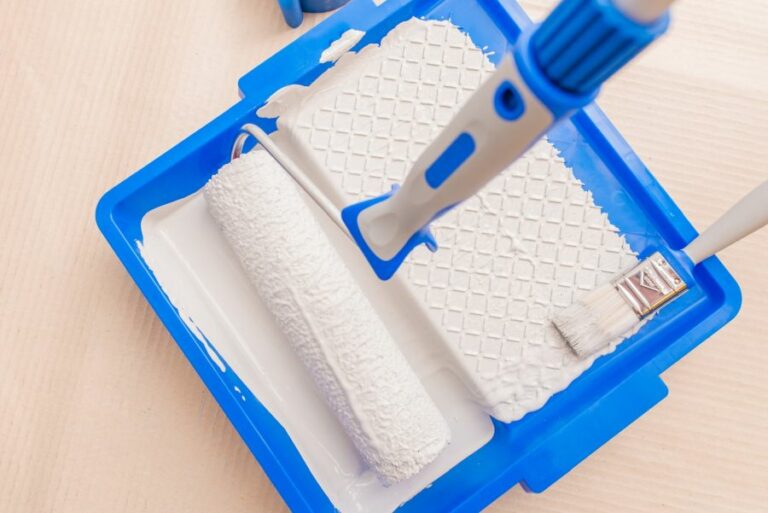Glossy Paint For Indoor Surfaces, 25 Things You Should Know
Glossy paint is undoubtedly the way to give indoor surfaces a fresh, stylish look. As experts in transforming spaces with a touch of glamor and sophistication, we’re here to share the wonders of this versatile, durable, and easy-to-clean paint option you’ve been searching for.
Glossy paint for indoor surfaces:
Glossy paint is popular for indoor spaces due to its appealing aesthetics, durability, easy cleaning, and moisture resistance. Glossy paint comes in different gloss levels and is available in oil- and water-based varieties, intensifying the appearance of colors. Preparation, application, and maintenance are crucial to achieving a stunning, durable finish.

Discover the magic of glossy paint for indoor surfaces! Transform your living space with a stunning finish that looks fantastic and offers easy maintenance. Read on for tips, tricks, and everything you need to know about enhancing your home with glossy paint. Don’t miss out!
Contents
Lustrous Interior Paint for Indoor Spaces
Glossy paint has become a popular choice for homeowners seeking a sleek, polished look for their interior spaces. With its eye-catching sheen, glossy paint not only adds a touch of elegance to walls and furniture but also provides an easy-to-clean surface.
• The Appeal of Glossy Finishes
Glossy paint finishes offer several distinct advantages for your home:
- Aesthetics: A glossy finish creates a luxurious, shiny surface that beautifully reflects light. This can enhance the appearance of certain colors and instantly elevates the look of any room.
- Durability: Glossy paint is often more durable than matte or flat finishes, which can wear more quickly and reveal imperfections on the surface.
- Easy to Clean: Glossy surfaces are less porous than their matte counterparts, making them more resistant to stains and easier to wipe clean.
- Moisture Resistance: Glossy paint’s low porosity also makes it a great option for kitchen and bathroom interiors, where moisture resistance is essential.
• Selecting the Right Glossy Paint
When choosing a glossy paint for your home, take the following factors into consideration:
– Type of Paint
There are several types of glossy paints available, including:
- Oil-Based Paint: This type of paint offers a high level of gloss and durability but can take longer to dry and may have a stronger odor. Oil-based paints are best suited for wood surfaces or surfaces with heavy exposure to moisture, such as bathrooms and kitchens.
- Water-Based Paint (Latex, Acrylic): Water-based glossy paints are easier to clean up, have lower odor levels, and dry faster than oil-based varieties. They can be used on a variety of surfaces, including previously painted surfaces, new drywall, and wood.
– Level of Gloss
Glossy paint is available in several levels of gloss: from semi-gloss to high-gloss. The higher the gloss, the more shine and durability the paint will have. However, keep in mind that higher gloss levels can also highlight surface imperfections.
– Color Selection
As with any paint project, color choice is essential. Glossy paint can dramatically impact the appearance of a room, so it is important to consider your desired aesthetic when choosing a color. Lighter colors will enhance the room’s brightness, while darker hues can create a more dramatic, moody atmosphere.
Additionally, glossy paint can intensify the appearance of colors, so you may want to choose a shade that is slightly lighter than your intended color.
• Preparing the Surface
Before applying any glossy paint, it is essential to properly prepare the surface to ensure a smooth and consistent finish. This includes:
- Cleaning: Wipe down walls, furniture, or other surfaces with a damp cloth to remove dirt, grease, and dust.
- Sanding: For uneven or previously painted surfaces, use medium-grit sandpaper to remove old paint and create a smooth surface fo the glossy paint to adhere to.
- Repairing: Fill in any cracks or holes with a putty knife and patching compound. Once dry, sand the patch smoothly to blend it seamlessly with the surrounding surface.
- Priming: Apply a high-quality primer to provide a base for the glossy paint. Priming also helps to block any stains and create a more uniform color.
• Applying Glossy Paint
Now that your surface is prepped, it’s time to apply the glossy paint. To achieve the best results, follow these tips:
- Use High-Quality Brushes and Rollers: Select brushes and rollers specifically designed for use with glossy paints, as they will provide a smoother application and fewer brush marks.
- Apply Thin, Even Coats: To achieve a consistent, high-gloss finish, it is essential to apply thin, even coats of paint. Be patient and resist the temptation to glob on the paint, as this will lead to uneven coverage and brush marks.
- Lightly Sand Between Coats: To create a silky, smooth surface, lightly sand the painted surface with fine-grit sandpaper between coats, removing any trace of dust before applying the next coat.
- Allow Sufficient Drying Time: Glossy paint requires adequate drying time between coats. Always follow the manufacturer’s recommendations for drying times, and avoid touching or disturbing the freshly painted surface during this period.
• Maintaining Your Glossy Paint Finish
To keep your glossy paint looking its best, follow these maintenance tips:
- Clean Regularly: Wipe down your glossy surfaces regularly with a damp cloth or sponge to remove dirt, dust, and fingerprints.
- Avoid Harsh Cleaners: Stick to mild, non-abrasive cleaners when cleaning your glossy paint surfaces. Harsh chemicals and abrasive cleaning tools can dull the paint’s finish.
- Touch-Up Imperfections: If you notice any chips or scratches in your glossy paint finish, use a small brush to carefully touch up the damaged area with fresh paint.
- Repaint as Needed: Over time, even the most durable glossy paint may start to lose its shine. Repainting the surface can help restore its original luster and vibrance.
In conclusion, glossy paint can add incredible depth and interest to your indoor surfaces. By selecting the right type of paint, color, and level of gloss, as well as carefully preparing the surface and applying the paint, you can achieve a stunning, durable finish.
Selecting the Perfect Gloss Level for Indoor Paint
Choosing the right gloss level for your interior paint job can greatly affect the overall ambiance and functionality of your space. Finding the perfect gloss can be overwhelming due to the numerous options available.
• Understanding Gloss Levels
Before diving into the best gloss for interior paint, it is crucial to understand the concept of gloss levels. Gloss refers to the amount of sheen or shine a paint finish exhibits. It plays a significant role in the overall appearance and durability of the painted surface.
Gloss levels are generally categorized into the following types:
- Flat/Matte
- Eggshell
- Satin
- Semi-gloss
- High gloss
Each gloss level offers distinct characteristics, advantages, and drawbacks. We’ll discuss each in detail below.
– Flat/Matte
Flat or matte finishes offer a non-reflective surface, giving your walls a smooth and even appearance. This gloss level is ideal for hiding imperfections, such as small cracks or uneven surfaces, as it diffuses light rather than reflecting it.
However, matte paint is less durable compared to other gloss levels and is prone to scuff marks and stains. It’s typically best suited for low-traffic areas such as bedrooms and ceilings.
– Eggshell
Eggshell finishes have a slight sheen, striking a balance between flat/matte and satin. This gloss level provides a warmer and more inviting ambiance while still offering good hide and durability.
Eggshell finishes are an excellent option for living rooms, dining rooms, and hallways, as they can handle moderate traffic while offering a pleasant visual appeal.
– Satin
Satin finishes exhibit a soft, pearl-like sheen, providing a sleek and elegant appearance. This mid-sheen level offers better durability and stain resistance than flat or eggshell finishes, making it suitable for higher-traffic areas.
Satin paint is recommended for areas such as kitchens, bathrooms, and playrooms, where increased resistance to moisture, stains, and daily wear is beneficial.
– Semi-Gloss
Semi-gloss finishes strike a balance between satin and high-gloss sheens, offering a shiny and reflective surface. This gloss level provides excellent durability, moisture resistance, and stain resistance, making it easier to clean and maintain.
Semi-gloss paint is an ideal choice for doors, windows, trim, and cabinets, as it can withstand frequent cleaning and wear without losing its sheen.
– High Gloss
High-gloss finishes exhibit a brilliant, glass-like sheen, giving your space a polished and sophisticated look. This gloss level boasts superior durability, moisture resistance, and stain resistance, making it incredibly easy to clean and maintain.
Due to its reflective characteristics, high-gloss paint is perfect for accent pieces or surfaces you want to draw attention to, such as doors, cabinets, or furniture pieces. However, this gloss level may highlight surface imperfections, so proper preparation is crucial.
• Factors to Consider When Choosing the Right Gloss Level
To determine the best gloss for your interior paint, it is essential to consider the following factors:
- Functionality: Think about the area’s purpose, traffic level, and exposure to moisture or dirt. Higher gloss levels typically offer increased durability and resistance, making them suitable for busy or moist spaces.
- Surface imperfections: Lower gloss levels, such as flat or eggshell, are better at concealing imperfections as they diffuse light. Consider the wall’s condition and if there are imperfections to be hidden when choosing your gloss level.
- Desired aesthetic: Each gloss level provides its ambiance and visual appeal. Consider the style and look you want to achieve for your space when deciding on the perfect gloss level.
• Making the Right Choice
Ultimately, the best gloss for your interior paint depends on your taste, the room’s purpose, and the condition of the surfaces you’ll be painting. For an expert opinion, consult with professional painters or your paint retailer to help you make the most informed decision.
For additional resources on how to choose the perfect gloss level for your project, visit the Paint Quality Institute.
Gloss Type | Advantages | Best Use |
|---|---|---|
Flat (Matte) | Hides imperfections, absorbs light, low reflection. | Low-traffic areas, ceilings, living rooms, bedrooms. |
Eggshell | Low-sheen, easy to clean, more durable than flat. | Dining rooms, living rooms, bedrooms. |
Satin | More durable, easy to clean, moderate reflection. | Kitchens, bathrooms, hallways, kids’ rooms. |
Semi-Gloss | Durable, easy to clean, higher reflection. | Doors, trims, cabinets, kitchens, bathrooms. |
Gloss | Highly durable, easy to clean, highest reflection. | Doors, trims, cabinets, furniture, high-impact areas. |
Discover the Most Lustrous Paint for Home Interiors
• Understanding Paint Sheens
Before diving into the shiniest interior paint options available, it’s essential to understand what a paint’s sheen or finish signifies. A paint’s sheen or gloss level is determined by the quantity of light it reflects.
The more light a paint reflects, the glossier and, in turn, shinier it appears. Generally, paint sheens can be categorized into the following types:
- Flat or matte
- Eggshell
- Satin
- Semi-gloss
- High-gloss
As we move down this list, the paint sheens become increasingly shiny, with high gloss being the shiniest option available for interior spaces.
• High-Gloss Paint Explained
High-gloss paints are the shiniest paints and reflect the most light, giving surfaces a sleek and polished appearance. These paints are ideal for areas that require regular cleaning and are prone to fingerprints, smudges, and general wear and tear. Examples of such areas include:
- Doors and doorframes
- Window trims
- Cabinets and molding
- Kitchens and bathrooms
- Children’s rooms
High-gloss paints not only offer a visually striking finish, but also provide excellent durability, stain resistance, and moisture resistance, making them ideal for high-traffic areas.
– Pros and Cons of High-Gloss Paint
Although high-gloss paint boasts an array of benefits, there are some downsides to using it in interior spaces. Here’s a quick look at the pros and cons:
Pros:
- Highly reflective, creating a vibrant and shiny appearance
- Easy to clean and maintain
- Resistant to stains and moisture
- Durable and long-lasting finish
Cons:
- Magnifies surface imperfections
- Not suitable for large wall areas
- Can appear too shiny or reflective in some spaces
- Requires proper surface preparation and a skilled painter
• Choosing the Right High-Gloss Paint
When selecting a high-gloss paint for your interior space, factors such as quality, brand, and color should be considered. High-quality paints offer better coverage, durability, and a smoother finish, making them a worthy investment.
Some reputable brands known for their high-quality high-gloss paints include:
- Benjamin Moore
- Sherwin-Williams
- Behr
- Valspar
- PPG
When choosing a color for your high-gloss paint, it’s crucial to keep in mind that darker hues will appear even glossier due to their higher light absorption quotient. This factor can help you achieve the desired level of shine for your interior space.
• Tips for Applying High-Gloss Paint
High-gloss paint can be tricky to work with, especially for inexperienced painters. Follow these tips for achieving a flawless and shiny outcome:
- Surface preparation: Properly clean, sand, and prime the surface to ensure a smooth and even application.
- Use a quality brush or roller: Investing in a high-quality brush or roller will help prevent streaking and other application issues.
- Apply multiple coats: Several thin coats typically provide a smoother finish compared to one or two thick coats.
- Maintain a wet edge: Keep a wet edge as you paint, working in small sections, to prevent lap marks and ensure an even finish.
- Allow ample drying time: Give each coat sufficient time to dry before any further touch-ups or applications are attempted.
• Alternatives to High-Gloss Paint
If high-gloss paint isn’t quite what you’re looking for, other sheen options can provide a semi-shiny finish. Consider semi-gloss or satin paints, which offer a subtler shine without compromising on durability and ease of maintenance.
Semi-gloss and satin paints work well in areas such as kitchens, bathrooms, and hallways, where both shine, and practicality are desirable qualities. It’s essential to select the sheen that best suits your interior space and aesthetic preferences.
• Conclusion
In summary, the shiniest interior paint available is high-gloss paint. This glossy finish offers an eye-catching appearance, durability, and ease of maintenance, making it ideal for high-traffic areas and surfaces prone to wear and tear.
Proper surface preparation, high-quality tools, and careful application are crucial for achieving a flawlessly shiny finish.
While high-gloss paint stands out as the shiniest option, consider alternatives like semi-gloss or satin paints for a more subdued shine. Ultimately, the sheen you choose for your interior space should align with your design preferences and your space’s practical requirements.
Achieving a Glossy Finish with the Right Paint
A glossy finish adds a shiny, reflective appearance to surfaces, making them more visually appealing and easier to clean.
• Types of Paints with Glossy Finishes
There are several types of paints that can provide a glossy finish, including:
– Oil-based Paints
Oil-based paints, also known as solvent-based or alkyd paints, offer a hard, durable finish with a high sheen. They are often used on woodwork, trim, and furniture because they provide an even, smooth surface and a lustrous appearance.
Oil-based paint can take longer to dry than other paints, so it is essential to allow enough time between coats.
– Water-based Paints
Water-based paints, also known as latex or acrylic paints, are popular for their easy clean-up and faster drying time compared to oil-based paints. They can also be applied to a variety of surfaces, including wood, metal, and masonry.
Some water-based paints are available in high-gloss finishes that resemble the appearance of oil-based paints. However, they may not be as durable as their oil-based counterparts.
– Enamel Paints
Enamel paints are a type of hard, glossy paint that creates a smooth, glass-like finish. They can be either oil-based or water-based and are typically used on surfaces such as doors, cabinets, and trim.
Enamel paints are known for their excellent durability, scratch resistance, and ability to withstand frequent cleaning.
– Lacquers
Lacquers are a type of clear or pigmented coating that creates a high-gloss, hard finish. They are typically applied with a spray gun and can be used on various surfaces, including wood, metal, and plastic.
Lacquers have excellent durability and require less maintenance than other paints, but they can be more challenging to apply and may not be suitable for all projects.
• Choosing the Right Paint for Your Project
When selecting paint to achieve a glossy finish, consider the following factors:
- Surface Material: Different paint types adhere better to specific surfaces. For example, oil-based paints are best for woodwork, while water-based paints are more versatile and can be used on a variety of materials.
- Durability Requirements: If you require a highly durable, scratch-resistant finish, consider using enamel paint or a lacquer finish.
- Drying Time: If quick drying times are essential, opt for water-based paints as they tend to dry faster than oil-based options.
- Ease of Application: Some paints, such as lacquers, can be more challenging to apply and may require specialized equipment. Ensure you have the necessary skills and equipment to achieve a professional-looking finish with your chosen paint type.
- Environmental Considerations: Water-based paints generally have lower levels of volatile organic compounds (VOCs) and can be more environmentally friendly than oil-based paints. If this is a concern for you, opt for low-VOC or VOC-free water-based options.
• Application Tips for a Glossy Finish
Achieving a professional-looking glossy finish requires proper surface preparation, correct application techniques, and adequate drying time. Follow these tips for a successful result:
- Clean and Sand the Surface: Before painting, ensure the surface is free of dust, dirt, and grease. Lightly sand any glossy surfaces to promote proper paint adhesion.
- Apply a Primer: A primer helps ensure even paint coverage and can enhance the final gloss level. Choose a primer designed for the paint type you plan to use.
- Thin Your Paint: For a smoother finish, consider thinning your paint with an appropriate thinner or reducer recommended by the paint manufacturer.
- Use the Right Applicator: For oil-based and enamel paints, use a high-quality, natural-bristle brush. For water-based paints, use a synthetic-bristle brush. Alternatively, you can use a foam roller or spray equipment for an ultra-smooth finish.
- Apply Multiple Coats: Applying multiple, thin coats allows for better leveling and a more even sheen. Allow for adequate drying time between coats, as recommended by the paint manufacturer.
• Recommended Paint Brands for Glossy Finishes
Here are a few popular paint brands known for producing high-quality glossy finishes:
- Sherwin-Williams: Offering a wide range of high-gloss paint options, this company is known for its durable and easy-to-apply products.
- Benjamin Moore: This reputable brand offers top-quality enamel and high-gloss water-based paints suitable for various surfaces.
- Valspar: This brand provides multiple high-gloss paint options that deliver outstanding durability and a smooth finish.
- Rust-Oleum: Known for specialty paints, Rust-Oleum produces high-gloss enamel paints and lacquers suitable for various surfaces, including metal and wood.
In conclusion, several types of paint can achieve a glossy finish, including oil-based, water-based, enamel, and lacquer paints.
Selecting the appropriate paint type for your project, considering factors such as surface material, durability requirements, drying time, and ease of application, will ensure a superior glossy finish.
Proper surface preparation, correct application techniques, and adequate drying time will further enhance the final results.
Choosing the Ideal Glossy Paint for Your Living Room
Selecting the ideal gloss paint for your living room can be a daunting task. With various types and finishes available, it’s essential to make the right choice to ensure the desired result, durability, and ease of maintenance.
• High-Gloss vs. Semi-Gloss
Gloss paint refers to the sheen or finish of a paint, which directly affects light reflection and maintenance. There are two main types of gloss paint: high-gloss and semi-gloss. Knowing the different characteristics of each will help you choose the best option for your living room.
– High-Gloss Paint
High-gloss paint offers a shiny, glass-like finish that gives your walls a polished appearance. This type of paint is highly reflective and durable, making it ideal for high-traffic areas in your home like hallways and kitchens.
However, its reflective nature tends to magnify imperfections on the wall surface, making it less forgiving when it comes to wall preparation and application.
Recommendation: Use this paint on accent walls or for highlighting trim, molding, and doors in your living room.
– Semi-Gloss Paint
Semi-gloss paint sits between a high-gloss finish and a satin finish in terms of sheen. It provides a softer, more subtle shine compared to high-gloss paint.
However, it has a lower light-reflective quality and is more susceptible to damage like chipping and peeling. Semi-gloss paint can hide minor wall imperfections while still providing some durability.
Recommendation: Apply this type of paint to living room walls for a sleek yet subtle look without the high maintenance of a high-gloss finish.
• Water-Based vs. Oil-Based Gloss Paint
In addition to the sheen levels, gloss paint can be classified by its base, either water-based or oil-based. It’s crucial to understand the differences to make a suitable choice for your living room.
– Water-Based Gloss Paint
Water-based gloss paint is a popular choice for its quick-drying properties, low odor, and ease of cleanup. It is also an environmentally friendly option compared to oil-based paint. This type of paint provides excellent resistance to yellowing and good adhesion, making it suitable for most surfaces.
Recommendation: Choose water-based gloss paint if you want to minimize fumes and reduce your environmental impact.
– Oil-Based Gloss Paint
Oil-based gloss paint is renowned for its durability and resistance to moisture. This type results in a smoother finish compared to water-based paint and is an excellent choice for areas exposed to humidity, such as bathrooms.
However, oil-based gloss paint takes longer to dry, produces strong fumes, and requires a more extensive cleanup process involving paint thinners.
Recommendation: Opt for oil-based gloss paint if you want a smooth, long-lasting finish and don’t mind the extra effort for application and cleanup.
• Tips for Applying Gloss Paint in Your Living Room
To achieve the best results when painting your living room, keep the following tips in mind:
- Prepare the Walls: Address any cracks and holes, sand the surface, and ensure it is clean and free of dust before painting. This extra effort will ensure a more even finish, especially when using a high-gloss paint.
- Use Quality Brushes and Rollers: Investing in high-quality brushes and rollers will help apply the paint evenly and avoid visible brush strokes.
- Apply Multiple Coats: Applying at least two or even three thin coats of paint will result in a better finish and increased durability. Allow each coat to dry thoroughly before applying the next.
- Ensure Adequate Ventilation: When painting indoors, ensure proper ventilation to minimize fumes and help the paint dry faster.
• Final Recommendation
When selecting the right gloss paint for your living room, consider the trade-offs between high-gloss and semi-gloss options and whether a water-based or oil-based paint best fits your needs.
Preparing your walls, using quality tools, and applying multiple coats will ultimately enhance your living room’s appearance and prolong the life of your paint job.
For more information on selecting the right paint for your home, visit The Paint Quality Institute website, which offers various resources and guidelines to help you make informed decisions about paint quality and application.







